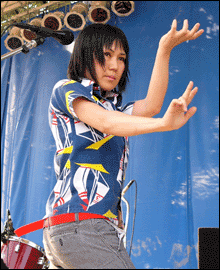“Some things seem really weird to me that seem really normal to other people,” says Deerhoof bassist Chris Cohen, on the phone from the Bay Area, where he’s on a break two weeks before the buzzed-about art-punk band heads east for a tour that begins January 24 at the Middle East Downstairs. If you’ve heard Deerhoof, you might assume that the opposite is true for Cohen and his bandmates: to make music as deliciously bizarre as theirs — agile, angular rock defined equally by catchy guitar-pop melodies and freewheeling distortion — you might assume that things considered really weird by other people must seem fairly normal to Cohen, guitarist John Dieterich, drummer Greg Saunier, and singer-guitarist Satomi Matsuzaki.
 No Deerhoof album has suggested that as much as The Runners Four (Kill Rock Stars), the band’s seventh full-length in less than a decade. Released last October, Runners is both Deerhoof’s most difficult and most accessible album yet. The band’s songwriting has sharpened; songs like “Spirit Ditties of No Tone” and “Wrong Time Capsule” are concise blasts of fuzzy garage rock, tuneful and grooving and laced with the sort of energy found in Revolver-era Beatles. Yet their taste for instrumental exploration hasn’t dimmed; opener “Chatterboxes” has long passages of spooky six-string tone poetry that evoke the song’s title.
No Deerhoof album has suggested that as much as The Runners Four (Kill Rock Stars), the band’s seventh full-length in less than a decade. Released last October, Runners is both Deerhoof’s most difficult and most accessible album yet. The band’s songwriting has sharpened; songs like “Spirit Ditties of No Tone” and “Wrong Time Capsule” are concise blasts of fuzzy garage rock, tuneful and grooving and laced with the sort of energy found in Revolver-era Beatles. Yet their taste for instrumental exploration hasn’t dimmed; opener “Chatterboxes” has long passages of spooky six-string tone poetry that evoke the song’s title.
For Cohen, “It’s not a dichotomy where weirdness and normalness are opposite poles and we’re thinking about how we’re gonna go between them.” He says the band’s approach is a more natural, intuitive one, in which “letting ideas develop” on their own is much more important than fitting those ideas into any preconceived scheme.
Still, he says, Deerhoof are incessant planners, always talking about where they should take the music — or where the music should take them. “It always starts with something. But every moment is this constant doubt and criticism, and everything changes a lot as we’re working on stuff. But having a goal in mind creates interesting things.”
For The Runners Four many of those goals were what Cohen deems “sound considerations.” He points to the band’s interest in pairing loud arrangements with Matsuzaki’s relatively quiet voice. “We like the idea of being able to treat all the instruments and vocals as independent things and having a lot of tension between them.” It can be difficult to recreate that balance in a live setting, since the relationship Matsuzaki’s vocals maintain with the music in the studio is enabled by microphones and a mixing board. So, Cohen stresses, the band focused on writing material that could be played live. One solution: “leaving a lot of space in the accompaniment so that when Satomi is singing, she might actually be audible in real life.” Cohen calls this the group’s “ultimate problem”; he says they’ll always be chipping away at it in one way or another.